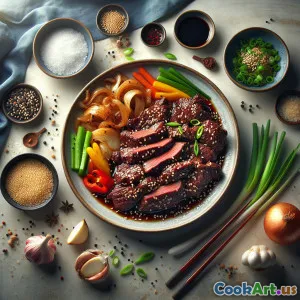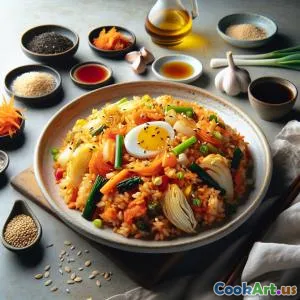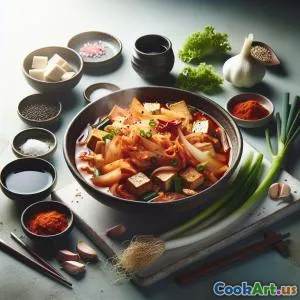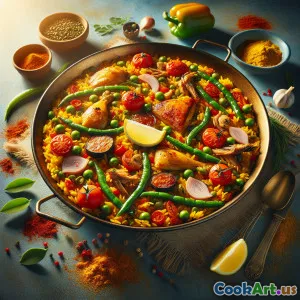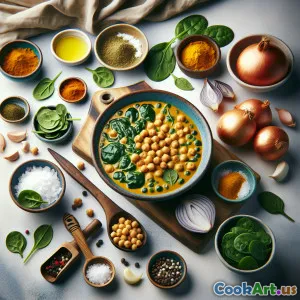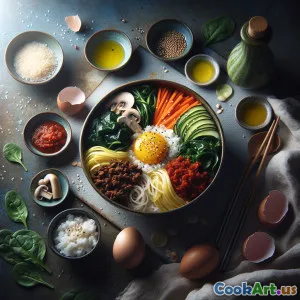
स्वादिष्ट रंगीन कोरियाई बिबिम्बाप नुस्खा
(Deliciously Colorful Korean Bibimbap Recipe)
(0 समीक्षाएँ)सामग्री
-
2 cups पका हुआ चावल
(Use short-grain rice for best texture.)
-
1 cup पालक
(Blanched and chopped.)
-
1 medium गाजर
(Julienned.)
-
1 medium जुकीनी
(Julienned.)
-
1 cup कुकुरमुत्ता
(Sliced (shiitake or button).)
-
150 grams गाउंड बीफ
(Can substitute with tofu for vegetarian option.)
-
2 large अंडे
(Fried sunny-side-up.)
-
2 tbsp Gochujang
(Korean chili paste, adjust to taste.)
-
1 tbsp तिल का तेल
(सजावट के लिए।)
-
1 tbsp तिल के बीज
(सजावट के लिए।)
(Use short-grain rice for best texture.)
(Blanched and chopped.)
(Julienned.)
(Julienned.)
(Sliced (shiitake or button).)
(Can substitute with tofu for vegetarian option.)
(Fried sunny-side-up.)
(Korean chili paste, adjust to taste.)
(सजावट के लिए।)
(सजावट के लिए।)
पोषण
- परोसने की संख्या: 2
- सेवा आकार: 1 कटोरा (350g)
- Calories: 600 kcal
- Carbohydrates: 80 g
- Protein: 25 g
- Fat: 20 g
- Fiber: 5 g
- Sugar: 6 g
- Sodium: 600 mg
- Cholesterol: 160 mg
- Calcium: 200 mg
- Iron: 3.5 mg
निर्देश
-
1 - Prepare Ingredients:
Wash and chop all vegetables. Blanch spinach and set aside.
-
2 - Cook Ground Beef:
In a skillet, cook ground beef over medium heat until browned. Season with salt and pepper.
-
3 - Sauté Vegetables:
In the same skillet, add carrots, zucchini, and mushrooms. Sauté until tender.
-
4 - Fry Eggs:
In a separate pan, fry eggs sunny-side-up until whites are set.
-
5 - Assemble Bibimbap:
In bowls, layer cooked rice, sautéed vegetables, ground beef, and top with fried egg.
-
6 - Serve:
Drizzle with gochujang and sesame oil. Sprinkle with sesame seeds. Mix before eating.
Wash and chop all vegetables. Blanch spinach and set aside.
In a skillet, cook ground beef over medium heat until browned. Season with salt and pepper.
In the same skillet, add carrots, zucchini, and mushrooms. Sauté until tender.
In a separate pan, fry eggs sunny-side-up until whites are set.
In bowls, layer cooked rice, sautéed vegetables, ground beef, and top with fried egg.
Drizzle with gochujang and sesame oil. Sprinkle with sesame seeds. Mix before eating.
स्वादिष्ट रंगीन कोरियाई बिबिम्बाप नुस्खा :के बारे में ज़्यादा जानकारी
Bibimbap is a traditional Korean dish that translates to 'mixed rice.' This colorful dish is not only visually appealing but also packed with nutrients from a variety of vegetables and proteins. Originating from Korea, bibimbap was historically enjoyed as a way to utilize leftover ingredients, creating a perfect balance of flavors and textures. The vibrant array of ingredients typically includes sautéed vegetables such as carrots, zucchini, and mushrooms, along with a protein like beef or tofu. The addition of a fried egg on top adds creaminess, while gochujang provides a spicy kick. Bibimbap's cultural significance extends beyond its delicious taste; it represents harmony in food, reflecting the Korean value of balance. This dish is often enjoyed in a communal setting, where diners mix the ingredients together, symbolizing unity. For a personal touch, feel free to experiment with different vegetables or proteins based on your preferences. Enjoy this delightful dish that not only satisfies hunger but also brings a piece of Korea into your kitchen!

